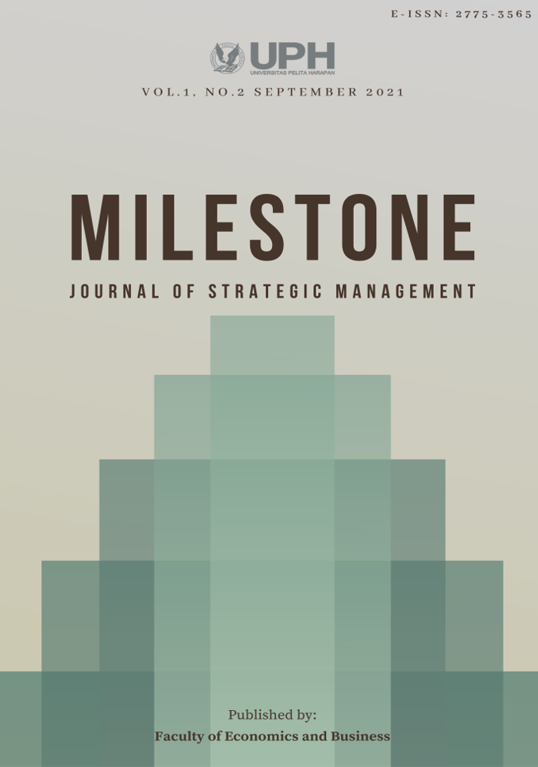Eksplorasi Perbedaan dan Interaksi Immersion dan Flow dalam Virtual Run Event [Exploration of the Differences and Interactions Between Immersion and Flow in Virtual Event Runs]
DOI:
https://doi.org/10.19166/ms.v1i2.3933Keywords:
flow, immersion, virtual run, eventsAbstract
This study aims to explore the differences between flow and immersion experiences and find the relationship between individual flow and immersion experiences in virtual run events. This research is qualitative research that uses narrative methods towards individuals by using interview for collecting information. The target of this study is the virtual run event participants from the period May-June 2021. This study involves informants who are sought through social media and personal relationships of the researchers. The search for informants was assisted by snowball sampling to be able to find informants who met the criteria. The results of this study found differences between flow and immersion and also the interaction between flow and immersion.
BAHASA INDONESIA ABSTRAK
Penelitian ini bertujuan untuk mengeksplorasi perbedaan pengalaman flow dan immersion dan juga mencari keterkaitan antara pengalaman flow dan immersion individu dalam virtual run event. Penelitian ini merupakan penelitian kualitatif yang menggunakan metode riset naratif terhadap individunya dengan menggunakan teknik wawancara dalam menggali informasinya. Target dari studi ini adalah peserta virtual run event dari periode Mei-Juni 2021. Studi ini melibatkan informan yang dicari melalui media sosial dan relasi pribadi dari peneliti. Pencarian informan dibantu dengan snowball sampling untuk dapat menemukan informan yang memenuhi kriteria. Dari hasil studi ini ditemukan perbedaan antara flow dan immersion dan juga interaksi antara flow dan immersion.
References
AyoLari.in (n.d.). Ayo lari: Statistik lomba Indonesia. Retrieved April 1, 2021, from https://ayolari.in/stats/
Berridge, G. (2012). Designing event experiences. In S. Page & J. Connell (Eds.), The Routledge handbook of events (pp. 273-288). Routledge. https://doi.org/10.4324/9780203803936
Carù, A., & Cova, B. (2005). The impact of service elements on the artistic experience: The case of classical music concerts. International Journal of Arts Management, 7(2), 39-54. https://www.jstor.org/stable/41064841
Carù, A., & Cova, B. (2006). How to facilitate immersion in a consumption experience: Appropriation operations and service elements. Journal of Consumer Behaviour: An International Research Review, 5(1), 4-14. https://doi.org/10.1002/cb.30
Caves, R. E. (2000). Creative industries: Contracts between art and commerce. Harvard University Press.
Creswell, J. W., & Poth, C. N. (2016). Qualitative inquiry and research design: Choosing among five approaches. Sage Publications.
Csikszentmihalyi, M. (1990). Flow: The psychology of optimal experience. Harper & Row.
Frochot, I., Elliot, S., & Dominique, K. (2017). Digging deep into the experience-flow and immersion patterns in a mountain holiday. International Journal of Culture, Tourism and Hospitality Research, 11(1), 81-91. https://doi.org/10.1108/IJCTHR-09-2015-0115
Hansen, A. H., & Mossberg, L. (2013). Consumer immersion: A key to extraordinary experiences. In J. Sundbo & F. Sørensen (Eds.), Handbook on the experience economy (pp. 209-227). Edward Elgar Publishing. https://doi.org/10.4337/9781781004227.00017
Jackson, S. A. (1992). Athletes in flow: A qualitative investigation of flow states in elite figure skaters. Journal of Applied Sport Psychology, 4(2), 161-180. https://doi.org/10.1080/10413209208406459
Jackson, S. A. (1996). Toward a conceptual understanding of the flow experience in elite athletes. Research Quarterly for Exercise and Sport, 67(1), 76-90. https://doi.org/10.1080/02701367.1996.10607928
Jovchelovitch, S., & Bauer, M. W. (2000). Narrative interviewing. In M. W. Bauer & G. Gaskell (Eds.), Qualitative researching with text, image and sound: A practical handbook (pp. 57-74). SAGE.
Krippendorff, K. (2004). Content analysis: An introduction to its methodology. Sage.
Nakamura, J., & Csikszentmihalyi, M. (2014). The concept of flow. In M. Csikszentmihalyi, Flow and the foundations of positive psychology (pp. 239-263). Springer. https://doi.org/10.1007/978-94-017-9088-8_16
Pine, B. J., II, & Gilmore, J. H. (1998). Welcome to the experience economy. Harvard business review, 76(4), 97-105.
Pinnegar, S., & Daynes, J. G. (2007). Locating narrative inquiry historically. In D. J. Clandinin (Ed.), Handbook of narrative inquiry: Mapping a methodology (pp. 3-34). SAGE Publications, Inc. https://doi.org/10.4135/9781452226552.n1
Swann, C. (2016). Flow in sport. In L. Harmat, F. Ø. Andersen, F. Ullén, J. Wright, & G. Sadlo, Flow experience: Empirical research and applications (pp. 51-64). Springer. https://doi.org/10.1007/978-3-319-28634-1_4
Swann, C., Keegan, R., Crust, L., & Piggott, D. (2016). Psychological states underlying excellent performance in professional golfers: “Letting it happen” vs. “making it happen”. Psychology of Sport and Exercise, 23, 101-113. https://doi.org/10.1016/j.psychsport.2015.10.008
Wattanapisit, A., Amaek, W., Sukkriang, N., Wattanapisit, S., & Wongsiri, S. (2020). Perspectives on using online platforms for promoting running and walking activities. Frontiers in public health, 8, 1-5. https://doi.org/10.3389/fpubh.2020.00150
Downloads
Published
Issue
Section
License
Authors who publish with this journal agree to the following terms:
1) Authors retain copyright and grant the journal right of first publication with the work simultaneously licensed under a Creative Commons Attribution License (CC-BY-SA 4.0) that allows others to share the work with an acknowledgement of the work's authorship and initial publication in this journal.
2) Authors are able to enter into separate, additional contractual arrangements for the non-exclusive distribution of the journal's published version of the work (e.g., post it to an institutional repository or publish it in a book), with an acknowledgement of its initial publication in this journal.
3) Authors are permitted and encouraged to post their work online (e.g., in institutional repositories or on their website). The final published PDF should be used and bibliographic details that credit the publication in this journal should be included.





